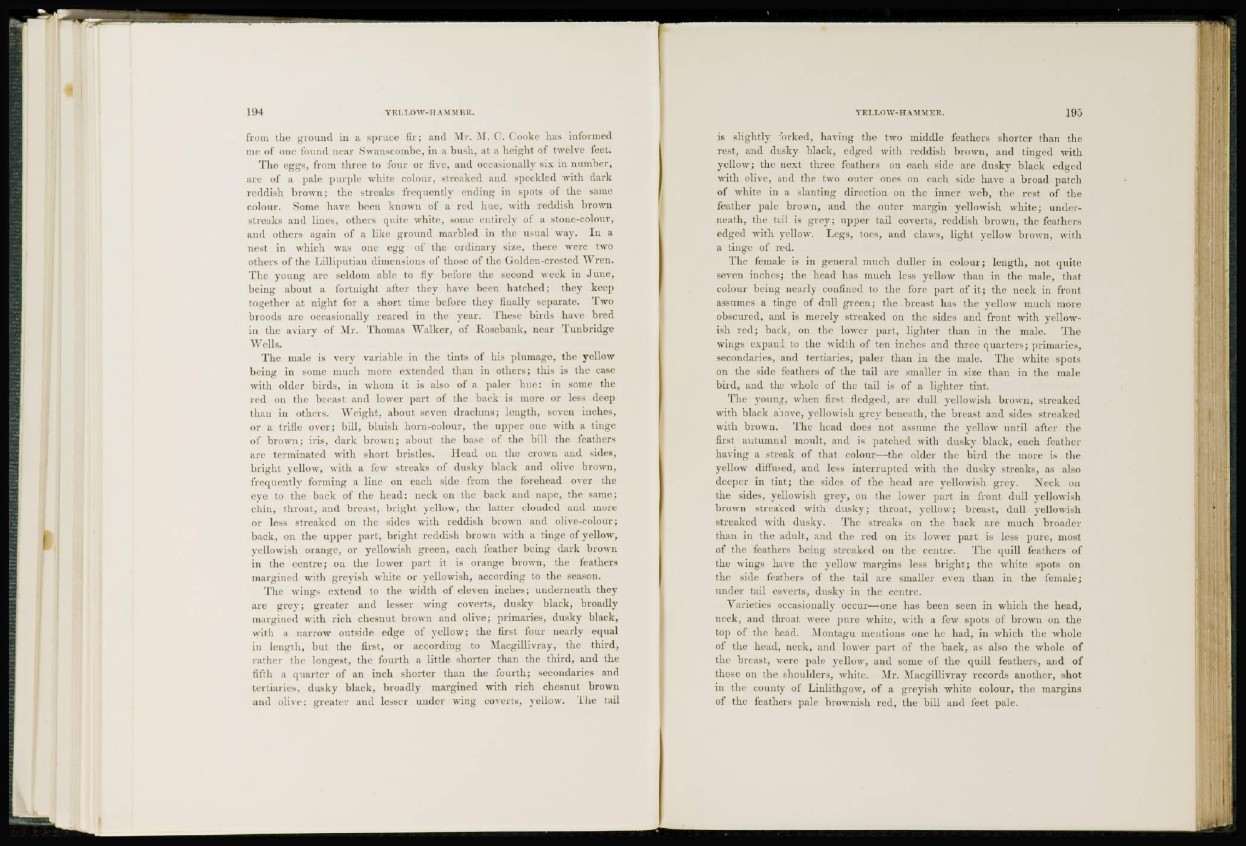
from (lie ground in a spruce fir; and Mr. M. ('. Cooke has informed
me of one found near Swanscombc, in • bush, at a height of twelve feet.
The eggs, from three to four or five, and occasionally six in number,
are of a pale purple white colour, streaked and speckled with dark
reddish brown; the streaks frequently ending in spots of the same
colour. Some have been known id' a red hue, with reddish brown
streaks and lines, others quite white, some entirely of a stone-colour,
and others again of a like ground marbled in the usual way. In a
nest in which was one egg of the ordinary size, there were two
other-- of the Lilliputian dimensions of t h o s e of the Golden-crested Wren.
The young are seldom able to fly before the second week in June,
being about a fortnight after thev have been hatched; thev keep
together at night for a short time before they finally separate. Two
broods arc occasionally reared in the year. These birds have bred
in the aviary of Mr. Thomas Walker, of Eosebank, near Tuubridgc
Wells.
The male is very variable in the tints of his plumage, the yellow
being in some much more extended than in others; this is the case
with older birds, in whom it is also of a paler hue: in some the
red on the breast and lower part of the back is more or less deep
than in others. Weight, about seven drachms; length, seven inches,
or a trifle over; bill, bluish horn-colour, tin1 upper one with a tinge
of brown; iris, dark brown; about the base of the bill the feathers
arc terminated with short bristles. Head on the crown and sides,
bright yellow, with a few streaks of dusky black and olive brown,
frequently forming a line on each side from the forehead over the
eye to the back of the head: neck on the back and nape, the same;
chin, throat, and breast, bright yellow, the latter clouded and more
or less streaked on the sides with reddish brown and olive-colour;
back, on the upper part, bright reddish brown with a tinge of yellow,
yellowish orange, or yellowish green, each feather being dark brown
in the centre; on the lower part it is orange brown, the feathers
margined with greyish white or yellowish, according to the season.
the win^ extend to the width of eleven inches; underneath they
are grey; greater and lesser wing coverts, dusky black, broadly
margined with rich chesuut brown and olive; primaries, dusky black,
with a narrow outside edge of yellow; the first four nearly equal
in length, but the first, or according to Maegillivray, the third,
rather the longest, the fourth a little shorter than the third, and the
fifth a quarter of an inch shorter than the fourth; secondaries and
tertiaiies, dusky black, broadly margined with rich chesnut brown
and olive: greater and lesser under wing coverts, yellow. The tail
is slightly forked, having the two middle feathers shorter than the
rest, and dusky black, edged with reddish brown, and tinged with
yellow; the next three feathers on each side are dusky black edged
with olive, and the two outer ones on each side have a broad patch
of white in a slanting direction on the inner web, the rest of the
feather pale brown, and the outer margin yellowish white; underneath,
the tail is grey; upper tail coverts, reddish brown, the leathers
edged with yellow. Legs, toes, and claws, light yellow brown, with
a tinge of red.
The female is in general much duller in colour; length, not quite
seven inches; the head has much less yellow than in the male, that
colour being nearly confined to the fore part of it; the neck in front
assumes a tinge of dull green; the breast has the yellow much more
obscured, and is merely streaked on the sides and front with yellowish
red; back, on the lower part, lighter than in the male. The
wings expand to the width of ten inches and three quarters; primaries,
secondaries, and tertiaries, paler than in the male. The white spots
on the side feathers of the tail are smaller in size than in the male
bird, and the whole of the tail is of a lighter tint.
The young, when first fledged, are dull yellowish brown, streaked
with black above, yellowish grey beneath, the breast and sides streaked
with brown. The head does not assume the yellow until after the
first autumnal moult, and is patched with dusky black, each feather
having a streak of that colour—the older the bird the more is the
yellow diffused, and less interrupted with the dusky streaks, as also
deeper in tint; the sides of the head are yellowish grey. Neck on
the sides, yellowish grey, on the lower part in front dull yellowish
brown streaked with dusky; throat, yellow; breast, dull yellowish
streaked with dusky. The streaks on the back are much broader
than in tin; adult, and the red on its lower part is less pure, most
of the feathers being streaked on the centre. The quill feathers of
the wings have the yellow margins loss bright; the white spots on
the side leathers of the tail are smaller even than in the female;
under tail coverts, dusk)' in the centre.
Varieties occasionally occur—one has been seen in which the head,
neck, and throat were pure white, with a few spots of brown on the
top of the head. Montagu mentions one he had, in which the whole
of the head, neck, and lower part of the back, as also the whole of
the breast, were pale yellow, and some of the quill feathers, and of
those on the shoulders, white. Mr. Maegillivray records another, shot
in the county of Linlithgow, of a greyish white colour, the margins
of the feathers pale brownish red, the bill and feet pale.